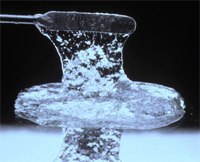 An inevitable fact of life is that we get older. That’s not a bad thing or a good thing; it is just the way the world works. Part of getting older is, hopefully, gaining experience and wisdom. Another part of getting older is becoming more yin-like � we dry up like a brittle leaf in autumn. As we dry up, we also tend to curl up and get smaller. One of the benefits of practicing yoga is to delay this inevitable trend.
An inevitable fact of life is that we get older. That’s not a bad thing or a good thing; it is just the way the world works. Part of getting older is, hopefully, gaining experience and wisdom. Another part of getting older is becoming more yin-like � we dry up like a brittle leaf in autumn. As we dry up, we also tend to curl up and get smaller. One of the benefits of practicing yoga is to delay this inevitable trend.
The gradual, inevitable decay at the end of life can take many years, even decades. Many people linger in ill health for a substantial portion of life before the cycle is completed. Dedicated yogis, however, have a much quicker demise. A yogini may not have a longer life span than others [1] but what is noticeable is that the level of health remains high for a much longer proportion of her life. When the final days approach, the decline is quite sudden. That may not sound so appetizing but which would you really prefer?
Yoga helps the body remain hydrated, fluid, and flexible long into the later years. This is one of the contributing factors to a longer period of good health late in life. Hydration applies to all our tissues. This was explored in detail in the section on Ground Substances. With respect to our joints, hydration is essential to their proper functioning.
We have seen that fibroblasts produce the molecules that attract and hold water in our tissues. There are four main molecules that do this for us, but hyaluronic acid (HA) is the biggest contributor to hydration. HA and the other hydrating molecules make up the synovial fluids that are key to keeping our joints lubricated. And the key to this is the number and productivity of the fibroblasts.
As we age we lose fibroblasts; the body just doesn’t produce as many. And those that the body does produce lose their productivity – they produce less HA. This is a double whammy that reduces the level of hydration in our tissues. This is why we dry up, curl up, and get stiffer as we age.
The treatment for this condition is not just replacing the lost HA, although there are many companies promoting supplements and injections just for this purpose. We cannot stop the age-related drying-out process, but we can delay it. The best approach is to not replace the missing HA and other water-attracting molecules, but to stimulate the growth of more fibroblasts and increase their production of these water-loving substances.
Fibroblasts are stimulated through stress. Squeezing, compressing, and stretching the connective tissues where fibroblasts reside stimulates them to produce more HA. The body also creates more fibroblasts under such conditions. With more fibroblasts, and more production from each one, the body rehydrates our tissues and joints more.
We have to make sure we are providing the stresses the tissues need and in an appropriate way. That is what yoga does. Yin Yoga specifically does this for the joints and the deeper connective tissues, but all yoga will do this for the more superficial and myofascial tissues as well.
We have just looked at four key reasons why we should add Yin Yoga to our yoga practice to protect and enhance our bones and our joints. There is another major reason relating to our joints and that is the benefits our spine gets from Yin Yoga. We will take a quick look at this next.
(Next: Spinal Curves )
